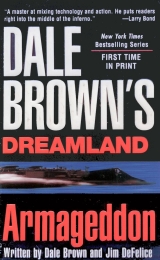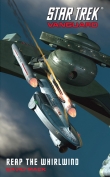
Текст книги "Armageddon"
Автор книги: Dale Brown
Жанр:
Боевики
сообщить о нарушении
Текущая страница: 10 (всего у книги 20 страниц)
“I think worse case scenario, we can still set them up,” said Danny. “We bring them into an area via helicopter, inflate them, and launch.”
“Really, Colonel, I think you’re pushing the development envelope here:’ said Rubeo.
“Oh, come on, Doc, they’ve passed all the preliminary tests,” said Dog. “They’ll provide round-the-clock coverage without us having to fly a Megafortress twenty-four/seven.”
“If they work.”
There was a knock on the door.
“Come,” said Dog.
“Am I interrupting?” Jennifer asked.
“Hopefully:’ said Rubeo.
“I brought some dinner,” she said.
“Great!” said Danny, helping her with the cooler.
“I didn’t realize it was a party:’ she said. “Or I would have brought more.”
Dog saw the disappointment she was hiding behind her smile.
I’m going to marry her, he thought. If she’ll have me.
“Jennifer, as an uninterested bystander,” said Rubeo, “is LADS ready to be deployed?”
Dog held his tongue.
“I don’t see why not. The technology is all off-the-shelf, with the exception of the airships themselves. Where?”
“Brunei,” said Rubeo.
“When are we leaving?”
“You’re not,” said Dog.
“Why not? I hear it’s a great place.”
“Until a few days ago,” said Danny. “There’s some sort of revolt or religious uprising going on”
Jennifer looked at Dog. Part of him wanted her along. The other part wanted her far from harm’s way.
“LADS isn’t your system,” he told hez.
“Technical people will have to be along,” she said. “Who’s going to supervise the engineering team? Ray?”
“Hardly necessary,” said Rubeo.
Dog looked at her. “We’re deploying tonight. I wasn’t planning on bringing a technical team. Danny’s people have already trained on the equipment.”
“You need a technical team. And maintainers.”
“For blimps?” said Rubeo.
“As a follow-on, sure,” said Dog. “After we assess the situation.”
“It should deploy with the weapons system.” Jennifer crossed her hands in front of her chest, the way she always did when she knew she was right. “And there should be an evaluation team as well, headed by a senior scientist.”
“Probably as a follow-on,” said Dog. “Depending on the situation. It’s volatile.”
“It is,” said Danny, who was munching on a chicken leg.
“We’re setting up camp at an oil platform, Jen. It’s not going to be a picnic.”
“I was in Iraq, remember?”
“We’ll bring the support team in once the situation has been assessed,” said Dog. “And an evaluation team.”
“I’ll be ready to take off in two hours,” said Jennifer, starting to leave.
“You won’t be needed until tomorrow afternoon at the earliest,” said Dog, pulling over the food. “Stay and have some dinner.”
Brunei
12 October 1997, (local) 0640
McKenna took a low pass over the palace compound. She saw a few figures moving near the building, but was moving far too fast to get a good read on what she was seeing.
“Dragon One to control—you have that forward-air-controller down there yet?” she asked as she pulled off. She wanted to get a handle on the ground situation and make sure she didn’t hit any of their own people.
“We’re working on it, Dragon One.”
“Well work harder,” she snapped. She watched her wing-mate come over the palace on the side near the sea. It didn’t appear as if anyone on the ground fired at him.
“Two, I’m going to take a real slow pass back over the dome,” she said. “Hang back and see if anyone fires at me. I want to get this sorted out”
The little Cessna poked her nose down toward the ground, settling down to a brisk walk over the compound at treetop level. This time McKenna saw several knots of men in what looked like white pajamas near the walls. These were obviously the guerillas.
Three bodies in plainclothes lay sprawled near the building. A green British Land Rover sat near the gate on the far side of the compound. McKenna saw a grenade explode near the vehicle. From this altitude, the shock of smoke appeared harmless, though she realized it was anything but. She saw a pair of vans parked on a side street, a large group of men in white near it.
The forward-air-controller finally came on over the police frequency. It was one of the security people who had been with Mack yesterday when he rescued her from the ministry. The man had received training in directing aircraft for attack, but it still took a few exchanges for her to work out where he was and vice versa.
“I’m going to hit those vans,” she told him once it was clear the government troops were not nearby. “Tell the officer in charge there.”
“Yes, yes, he says do it.”
McKenna tipped forward in her seat, pushing against the restraints as the ground flew through the optical sighting panel ahead of her. The wind was minimal, and as she came in from the water side she had a clear run at the vans. Still, the close quarters and her low altitude made the bombing run dangerous as well as complicated; for the first time since she’d arrived she saw tracers arcing in her directions. She hunched her body around the stick, ignoring them, ignoring everything but the slowly changing view and pipper marks in front of her eyes. The vans jerked into her crosshairs and she pickled, loosing all four bombs as she pulled back on the stick. Heavy flak erupted just off her left wing as she climbed. McKenna coaxed the Cessna upward as the air began percolating and rumbling with the exploding shells. She cleared right into the open air and saw her wingmate about a thousand feet above her and a quarter mile to the south.
“Two, where was that flak coming from?”
“Tank mounted weapon,” said the other pilot.
“One of ours?”
“Looks like.”
The weapon was apparently a Brunei army vehicle that had been stolen from its base. A Panhard M3 VDA, the French-built twenty-millimeter cannon had radar guidance but was apparently being operated by sight—otherwise McKenna would have been perforated. The gun was now being used to chew up the area in front of the highway at the entrance to the palace compound; guerillas were moving behind it.
“Two, can you get that gun?” McKenna asked.
“Roger that,” said the copilot.
“I’m going to cover your butt and clean up after your pass,” she added, working the A-37B around.
IT HAD GONE BETTER THAN SAHURAH HAD DARED IMAGINE. Besar, though clearly a degenerate, had pulled off the impossible and stolen the self-propelled cannon from under the noses of the army. Their main force was now in control of two of the four sides of the palace perimeter; inside, they were engaged in a battle with forces in the main ministry building. Once they took care of those forces, they could move on to the palace itself, using the roof of the ministry to lay down gunfire.
Two jets danced overhead. Sahurah looked up from his position as one of the planes dropped its bombs on the city-side and the Panhard anti-aircraft gun began firing. He wasn’t sure what the target was; Besar had a command station in that area but from where Sahurah stood he could see nothing.
One of his squad leaders motioned from the corner of the building. Sahurah ducked his head and ran forward, sliding down as he neared the man. The headache that had haunted him yesterday was gone and he had fresh hope—perhaps he would die today and become a martyr.
“Commander, the enemy has a machine-gun inside the building,” said the squad leader.
“Bring up the rocket-propelled grenades,” said Sahurah. Another jet passed overhead. Sahurah flinched, then felt himself flush with shame at his momentary cowardice. Human, perhaps, but a failing before the eyes of God.
He grabbed the rifle from one of the men nearby and stepped but as another aircraft passed, emptying the magazine.
MCKENNA WATCHED HER WINGMAN’S BOMBS FALL ON TARGET and took her plane further east, where a fresh clump of white-pajamas ran for the wall. She pressed the trigger and the Dragonfly’s gat began spinning, drawing a red line through the scattering sea of white-clad fanatics. She stayed on the trigger a bit too long, and pulled off into a thick cloud of smoke; she completely lost track of where she was.
By the time she cleared she had flown out of the capital and was now over the lagoon-city in the bay. She regrouped with her wingman, who sounded as if he were hyperventilating after his successful bomb run.
The situation in the palace was growing desperate. Several hundred guerillas had attacked the compound; there were less than fifty army defenders, along with some plainclothes security and a dozen or so policemen. Reinforcements were engaged in a fierce fight at a guard post outside the city; it was unlikely they could reach the palace to prevent its being taken.
The sultan had strapped a gun on his side and was with the army commander inside.
McKenna started back toward the compound. The guerillas were clumped at one end of the water beyond the highway, but did not yet control the roadway.
“Get a helicopter over here on the double and get the sultan the hell out,” McKenna told her controller back at the airport. “We’ll cover the approach.”
“Helicopter is forty minutes away.”
“Forty minutes!”
“It’s coming up from Tutong,” said the controller.
Smoke began pouring out of the side of the ministry building. “Can you get some sort of boat in to make a rescue?” McKenna asked.
“The navy is working on that.”
That wasn’t going to do. White-pajamas were swarming all over the place. McKenna tipped downward and spit shells at them, but she barely made a dent. The Dragonfly rocked as it took a few bullets in the right wing.
“Yo, ground FAC, what’s your situation?” she asked as she recovered on the city side of the compound.
“Under fire.”
“The sultan there?”
“Yes. We’re going to retreat to the south.”
“Negative! Negative!” she said, catching sight of three pickup trucks filled with white-pajamas. “No, listen, can you get out to the highway near the main entrance?”
“Maybe”
“Get the sultan there” She spun back around, sizing up the roadway. It was straight, relatively flat, and unobstructed—if you didn’t count the two burning cars about thirty yards from the palace gate. “Push the cars off to the side and wait,” she said.
“For what?”
“Just get those cars out of the way.”
South of the Philippines
0653
Mack turned the helm over to his copilot and undid his restraints, stretching as he got out of the pilot’s seat. One advantage the Megafortress had over an F-15—a working galley at the rear of the flightdeck.
Not to mention a microwave and a convenience area, otherwise known as a john. All the amenities of modern life.
The Sparrow had worked well enough for Mack to set the arms dealer down in one piece—and to order another dozen, as well as some heavier arms for his ground soldiers. The first variants of the Sparrow had seen action in Vietnam, where they had proved rather disappointing. The latter versions, however, were considerably more successful.
Unfortunately, the ones they had just bought were early models. Mack knew that some of the failures were due to pilot training—Naval aviators had been behind the triggers, ‘nuf said in his book. But even an air force jock with an oversized ego like Mack Smith had to admit that the hardware wasn’t quite on par with the AMRAAM, let alone Dreamland’s improved version of the AMRAAM, the AMRAAM-plus, also known as the Scorpion.
On the other hand, they were better than no arrows at all.
Mack had a drink of water and went and checked with his men downstairs, giving them all a thumbs-up for a job well done.
“How we looking, Jalan?” he asked his copilot when he returned to the flightdeck.
“On course, sir. Estimated time of arrival is now two hours and three minutes.”
Mack brought up the course screen on the configurable display at the left side of his dash. The wall of instruments that constituted his “office” was infinitely configurable, constructed from a thick layer of touch-sensitive chips. Nearly every Megafortress pilot found it easiest to use a preset one, which divided the dash into large panels of multi-use and devoted displays. Mack had a little trouble with the course module, and it took a minute to get the large-area map he wanted, showing the large island of Borneo and the surrounding water. He then double tapped the compass icon with his finger, and drew the course he wanted.
“Compute,” he told the computer, and a window opened in the screen showing what it would take to patrol the eastern portion of the island where the Sukhois were.
It was a detour, but a strategic detour. He’d have plenty of fuel—as long as he cut over Malaysian territory to get home. “Jalan, we have a new course,” said Mack.
“Yes, sir,” said the copilot, who brought it up on his own screen. He studied it for a moment. “Minister, should I alert Ground to the changes?”
“I don’t believe we’re in range to notify Ground,” said Mack.
“Sir?”
“Let’s stay silent com for a while,” said Mack. “We’re only going to add about an hour to our flight plan, maybe even a little less,” he added, putting his hand to the throttle bar.
Brunei
0654
The men who had put pencil to paper and designed the Cessna Dragonfly some forty years before had set out to accomplish some deceptively modest goals. They wanted to create a sturdy, predictable aircraft that didn’t cost all that much to operate, and yet could provide a novice pilot with a suitable learning environment, one that would help him transition to the hot jets at the time. They surely did not envision that their aircraft—beefed up, to be sure, but still the same basic design—would not only be flying as the century came to a close but would be doing so in combat situations.
And surely they never envisioned doing what McKenna intended as she dropped low toward the highway that spanned the waterfront outside the palace.
The A-37B’s wings were just a hair under thirty-six feet wide—short maybe for an airplane, but a bit wide for this roadway. But McKenna judged that she could make it as long as she stuck to the left side of the road as she came in.
Problem was, that was where they were pushing the wrecked cars.
Something flashed at the right side of the aircraft as she approached. The explosion was a good distance away but McKenna realized she couldn’t afford the luxury of a second approach; she might make it down only to be swarmed by the guerillas.
“FAC, where’s the sultan?” she asked.
“Ready! Ready!”
“Push that other car out of there, way off the road!” she said. “And get down. I’m coming in.”
McKenna gave the throttle a light tap for luck then pushed in for her landing. She touched down slightly right of where she wanted to, but still had enough clearance to get by the light poles. The men pushing the car ahead saw her coming and gave the vehicle one last shove before throwing themselves out of the way; her wing cleared the fender by perhaps three feet, which as far as she was concerned was a country mile.
As the Dragonfly rolled to a stop, McKenna popped the top; she pushed her feet up and saw three men in suits running toward her. The sultan, a trim man in his early sixties, athletic and with a movie star’s face, appeared at the side of the aircraft. He said something, but although the A-37 had many assets, quiet engines were not one of them. McKenna shouted at him to get in; he pulled himself over the side and practically fell into place as she got the plane moving again. Bullets were exploding against the concrete nearby; she saw the shadow of her wingman pass overhead, suppressing some of the ground fire from the seawall on the left. The ground began to shake with explosions; McKenna reasoned that they were either very large or very close, or both.
There was no question of turning around to take off into the wind. The way in front of her was clear, though short.
Could she make it?
The Dragonfly was made for short field operations and this one was light on fuel, with hardly much of a load. More importantly, McKenna was desperate. She gunned the engines, revving the J85s to the red line.
“Yee-haw!” she shouted as they cleared the wall at the edge of the highway by a good two inches. “Brunei Dragon One is off the ground and looking for permission to land,” she told her controller.
“Negative, negative—we’re under attack!” said the controller. “Airport is not secure! Airport is not secure!”
McKenna turned toward the sultan. He didn’t have a headset.
“We can’t land at the airport,” she shouted to him. “But I’ll take care of you, Your Majesty. Don’t fret”
Whether he understood what she said or even heard it all, he gave her a thumbs-up.
Aboard Brunei Air Force EB-52 1 (Jersey), over the Sulu Sea (northeast of Borneo)
0720
Mack studied the radar warning screen, which showed the range of the radar covering the northeast tip of Malaysian territory. The Megafortress was well out of range of the radar, but what was interesting to Mack was the type of radars that had been detected—a large-band system identified as a Russian P-37 Bar Lock, and a shorter-range P-15 Flat Face. Malaysia was not known to possess either, and Mack hadn’t encountered them on Borneo before. The P-15 Flat Face was especially troubling, since it was designed to work with surface-to-air missiles—SA-3s or more capable SA-6s and SA-8s. Any of those missiles could splash an A-37B without breaking a sweat, and even a Megafortress couldn’t afford to completely ignore SA-6s or SA-8s.
“We’re abreast of Sandakan,” reported Jalan, as they reached one of the waypoints programmed for a course change.
They brought the Megafortress onto the new course heading, still skirting Malaysian territory. Mack checked with his radar operators; with the exception of a commercial flight far to the south, they were the only plane in the air.
“Sixty seconds to Darvel Bay,” noted Jalan.
“All right, boys, this is for keeps now,” said Mack. “I need everybody on their game. We’re going to be over hostile territory for thirty minutes. Ready?”
He spoke to each crew member, more in hopes of giving them a boost than making sure they were ready.
Did it work? Did telling Jalan he was going to “kick butt” make the copilot handle his instrument screens any faster, or make his hand more assured on the stick? Did the radar operators click through their panels quicker?
There was no way of knowing; Mack realized he was going to have to take it on faith that it did help somehow. They took the Megafortress to three thousand feet, enough to see … and be seen.
“Patrol ship is trying to lock on us with his radar,” reported Jalan as they crossed over land. “He’s—we’re out of range.”
Mack concentrated on his course, nudging the stick slightly at their next waypoint, flying on a diagonal toward the mountains at the center of the island. The air in front of him gave no clue of the danger; a few wispy clouds hugged the far side of the mountains but the rest of the sky was clear and bright.
“Anti-aircraft radar operating?’ said Jalan, noting a ZSU-23-4 emplacement off their left wing. This low they were easy targets, but Mack had the element of surprise on his side, and was beyond the flak dealer’s range before it could fire. In the meantime, they mapped the small army base protected by the weapons, finding six helicopters out in the open and possibly more in a hangar. The helicopters, identified as American Hueys or similar civilian models by the computer system, did not appear on any of the force estimates of the Malaysian army. The computer recorded all of the data they collected, allowing it to be analyzed later.
“P-15 Flat Face,” said Jalan, repeating an alert just now flashing onto Mack’s warning screen, accompanied by an audible buzz. “Should I go to ECMs?”
“Hang off a second,” said Mack. “We got a location?”
The radar unit was near Kalabakon, a small city a few miles from the coast.
“Airfield, Mr. Minister!” said one of the operators. “I have it on the video.”
As Mack reached to bring the image onto his screen, the RWR barked out a warning that they were now fat in the target pipper of the missile system connected to the Flat Face radar. A J-band radar had begun tracking them, indicating that the system was ready to fire.
“ECMs,” said Mack.
Before Jalan could even punch the buttons the Malaysians launched two SA-8 missiles. The missiles had an effective range of roughly sixteen miles, but they had been launched near the edge of that envelope and within seconds the Megafortress had disrupted the ground link, obliterating the I-band guidance radar and persuading the missiles to veer off course.
“Good,” said Mack as the missiles detonated several miles to the south. “Hang on, now—let’s get some close-ups of that airfield, shall we?”
He wheeled the big plane over in the sky and put her nose on a line to the airfield they’d seen, pulling upwards of eight Gs briefly as he twisted in the sky. He felt himself being pushed and pulled by gravity as the plane whipped toward the earth, its momentum shifting abruptly. The Megafortress wasn’t a fighter jet, but damn, she could get out of her own way when she had to.
“ECMs—give ‘em the whole symphony,” said Mack as the warnings sounded again.
There were more SA-8s, as well as anti-aircraft cannons and a battery of very short-range IR seekers, ID’d by the computer after analyzing the video feed. Mack had the airstrip fat in the left part of his windscreen—it had been shaded to make it look like a pair of different roads, and to the naked eye there looked like there was a hill about midway down and a ditch at the western end. The camouflage had undoubtedly been meant to fool satellites or high-altitude spy planes. Mack saw a missile battery on the right side—it was an SA-8 launcher, a large amphibious vehicle with what looked like a tray of missiles on top. The back of the tray exploded; one of the missiles took off, fired pointblank toward the Megafortress.
Mack threw the plane left, firing off defensive chaff and flares while Jalan stayed on the ECMs. The SA-8 had been launched “blind,” its radar guidance completely blitzed by the Megafortress’s ECMs. The missile sailed high over the right wing, climbing to forty thousand feet before imploding.
More dangerous were the two missiles with infrared guidance launched just as the Megafortress passed. These were M48A1 Chaparrals—very short-range heat-seekers that were essentially ground-launched versions of the AIM-9D Sidewinder. Mack’s maneuvers had cost him some speed, and one of the missiles ignited less than a hundred yards from his right wing sending a spray of shrapnel into the back of the fuselage. But the damage was minor, and they climbed through the neighboring mountain valley without a problem.
“Did you locate the Su-27s?” Mack asked the radar operator. “Negative,” said the man. “No hangars visible.”
“Well they have to be there somewhere,” said Mack. “All right, one more pass”
This time, Mack went low—very low, as in twenty feet from the ground, covering his approach with a salvo of flares and chaff as well as the active electronic countermeasures. The ground defenders were either confused, out of arrows, or both, and the Megafortress passed unscathed.
They found the hangar, a dug-in bunker on the south side of a hill facing away from the runway, reached by a short dirt road.
“Got to give them points for ingenuity,” he told Jalan. “We’ll work up some sort of attack on the base when we get home. We can drop some of those five-hundred-pound bombs and put a big crater about midway down that runway, and keep them quiet for a while, but we’re going to need air-to-ground missiles to do anything about the hangar.”
“Striking the defenses would also be a good idea,” said the copilot.
“They were pretty inept.”
“They were caught off guard,” said Jalan. “They won’t be next time.”
As they climbed over the mountains in the direction of home, the ops detected a number of Malaysian helicopters flying near the Brunei border to the west, flitting in and out of radar coverage as they skimmed through the mountains. They were undoubtedly supporting guerillas, Mack thought, though he suspected the Malaysians would claim they were fighting them.
The sultan better put the bastards on notice that allies were supposed to help legitimate governments, not homicidal maniacs, Mack thought. He had the computer calculate a flight path to the area where the helicopters were operating, toying with the idea of unleashing one or two of the Sparrows at them; there were five left on the rotating dispenser in the rear bay. Before he could decide, Jalan relayed a warning that one of the Sukhois was taking off from the airfield they’d buzzed.
“That was fast,” said Mack.
“They must’ve been standing by in the hangar,” said Jalan. “Or they have a better hide near the field we didn’t spot.”
There was no doubt in Mack’s mind that he was taking on the Sukhois; the only question was where.
He decided he’d lead them out to sea before turning to tango. That way he’d avoid any nasty surprises like Malaysian ground-to-air defenses that he hadn’t spotted. He’d also have a quicker route home; his fuel gauges were trending toward empty.
“What it’ll look like to them is a big sitting ducking trying to foolishly outrun them,” Mack explained to Jalan as he laid in the course to the computer. “They’ll figure they have us nailed. We’ll fire two Sparrows at each plane once we have them flatfooted.”
“What if they’re carrying radar-guided missiles as they were the other day?”
“Oh, they definitely will be. You’ll just confuse the hell out of them with your ECMs,” Mack said. “I’ll handle the Sparrows.”
They had about a five minute lead on the two Malaysian planes as they reached the coast. Mack used some of it to climb to thirty-five thousand feet, then told Jalan to open the bomb bay door, preparing the Sparrows for firing. As their air speed dropped, the Sukhois came charging at them. The interceptors were spread nearly three miles apart, much more wary than they had been the other day; they’d thought about their encounter and tried to learn from it.
Which he was counting on.
“We’re going to make it look like we want to get them with the Stinger, turn, and then turn again,” he told his crew. “If you have to puke, do it now.”
One of the ops laughed and Mack smiled to himself—he was finally getting through to these guys.
“We’re spiked,” said Jalan, meaning that the targeting radar in the lead Su-27 had locked onto them.
That was the signal Mack had been waiting for.
“Break it,” he said calmly. Then he put Jersey into a wide turn to the north.
The lead Su-27 started to turn as well, planning to parallel his course while his partner came around and cut him off. As the Sukhoi tried to get close enough for heat-seekers or maybe a cannon shot, Mack pushed his stick harder and tucked the plane due south. The plane seemed to skid in midair as if she were a massive motorcycle pulling a one-eighty. It took a few seconds to get the wings back level; by that time the Su-27 pilot had tightened his own turn as well. Mack now twisted south and then back, snaking through the sky in a series of feints until the Sukhoi finally bit on one of his fakes. The enemy pilot shot off to Mack’s right, realized it had been fooled, and tried to dive away.
“Locked,” said the computer. “Range five miles.”
“Fire Sparrow One,” said Mack.
“Missile is launched”
“Fire Sparrow Two,” said Mack, seeing the diamond in the targeting screen close around the target.
“Target is locked Launching.”
With the missile away, Mack immediately turned back to the east, looking for the second Sukhoi. He expected the first to take a head-on approach, but found him flying parallel five miles ahead, and actually moving more than fifty knots slower than the Megafortress.
“Computer, lock target two.”
“Locked. Range five miles.”
“Fire Sparrow Three.”
“Missile is launched.”
Mack was about to launch another Sparrow when Jalan warned that a radar had locked on them. Mack, surprised, fired off chaff and took two quick cuts in the air. He had no idea which radar could be tracking them.
“Score one Sparrow!” said Jalan excitedly.
“What about that radar?”
“Still tracking us.”
Paranoia surged through Mack as he continued to have trouble picking up the opposing fighter. Just as he felt convinced—absolutely convinced—that the Su-27 was locked on his butt, he finally spotted the red dagger at the right corner of his screen. He started to pull the Megafortress around but Jalan yelled a warning over the interphone.
“Missiles! Missiles!”
Mack flailed back east, unable to sort the situation out in his head. He had one Sukhoi down, but must have missed the second one somehow. He blew a hard breath into his oxygen mask, trying to concentrate on what he needed to do, not on what he’d missed. Jalan and the computer ID’d the missile as a radar-guided R-27R. Mack flailed desperately in the air, zigging and zagging and dispensing the last of his chaff. The missile avoided the tinsel and hung with the Megafortress until it was about three hundred yards away; finally, the ECMs managed to shake it off. Desperate, a little angry at being jilted, the missile immolated itself as soon as it realized its date wasn’t showing up. Part of the warhead flew through the Megafortress’s number four engine, outboard on the right wing. The engine instantly lost power; Mack felt the wing tug downward before the computer helped him trim the plane to compensate.
“Jalan, we’ve lost engine four,” said Mack calmly.
“Yes. Mr. Minister,” said the copilot, already double-checking the computer’s automated safety programs.
Meanwhile, Mack spotted the remaining Sukhoi beginning a turn toward him from ten miles away; the computer announced that it had once more locked on the target.
“Fire Sparrow Four,” said Mack.
The missile clunked off the rotating launcher in the rear. Mack once more changed direction, but this time the Sukhoi pilot didn’t have a chance to target him.
“Score Sukhoi number two!” said Jalan.
They could see this explosion, a black puff in the distance at just about their altitude. Mack felt his shoulders sag; he’d been flying for hours without much sleep, and however good it felt to nail two enemy planes there was no way to put off fatigue forever.








